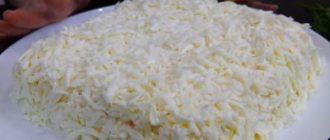Greek salad - one of the popular vegetables salads.
In Greece they call it “village salad”.
Light but filling with excellent taste. Easy to prepare. Popular and loved both in our country and throughout the world.
Today we will look at the classic recipe for a real “Greek” salad. You will find out the composition of the ingredients included in it.
We have translated a dozen Greek culinary sites.
And it will be an authentic recipe, the same as it would be served to you in Greece.
Its concept is a traditional village salad, the freshest vegetables and a simple dressing.
This is a classic recipe. If you decide to prepare what is called a “Greek” salad, and not what is served in restaurants, strictly follow the rules.
How to make Greek salad dressing - 15 varieties
- Classic Greek salad dressing
- Greek Salad Dressing with Balsamic Vinegar
- Greek salad dressing with soy sauce
- Greek salad dressing with mustard
- Greek salad dressing with mayonnaise
- Greek salad dressing with honey
- Greek salad dressing with basil
- Egg yolk based Greek salad dressing
- Easy Greek Salad Dressing
- Greek salad dressing with mayonnaise and nutmeg
- Pesto sauce for Greek salad
- Greek salad dressing with spices
- "Universal" dressing for Greek salad
- Greek Yogurt Salad Dressing
- Greek Salad Dressing with Dried Spices
Classic Greek salad recipe
There are also secrets in preparing Greek salad that must be taken into account. It seems complicated: chop the vegetables and soft cheese, season them and mix thoroughly. But it's not like that at all. The original recipe for Greek salad with Feta cheese does not involve mixing the ingredients, but laying them out in layers.
To prepare this dish you will need the following ingredients:
- 4 medium-sized tomatoes;
- 2 cucumbers;
- 1 large green sweet pepper;
- ½ onion (sweet, purple);
- 150 g feta;
- 8 pieces of black olives;
- some capers;
- dressing prepared according to the recipe suggested above.
All ingredients for the salad are chopped coarsely and laid in layers in a certain sequence.
1. Cut the cucumbers: small into circles, large ones in half again. Place on the bottom of the salad bowl.
2. Core the pepper and cut into half rings. Place on top of the cucumbers.
3. Peel the tomatoes from the stalk and cut into four parts.
4. The onion is cut into half rings. After this, it needs to be washed in cold water to remove the bitterness. Squeeze the onion and place it in the next layer after the tomatoes.
5. Decorate the dish with capers and olives, which do not need to be pre-cut.
7. Place a whole piece of cheese on top and pour the remaining dressing over it.
8. Immediately before serving, add salt, pepper and stir the Greek salad. At the same time, the Feta cheese is carefully broken into large pieces.
This is how Greek salad is prepared in its homeland. However, many chefs in different countries have long abandoned the traditional recipe and offer restaurant visitors a dish containing other types of cheese.
Classic Greek salad dressing
Preparing a classic dressing does not take much time. But, whatever, this is the simplest and most successful option. Everything you need for this can be found in any nearby store.
Ingredients:
- Lemon juice – 100 ml
- Olive oil – 100 ml
- Salt
- Pepper
Preparation:
Mix olive oil and lemon juice with a whisk. Add salt, pepper and mix thoroughly again. Oregano is a popular ingredient in Greek salad dressing.
If desired, you can add a pinch of fresh oregano
The history of Greek salad
In Greece, the homeland of this famous salad, it is considered rustic. And all thanks to such a simple composition. Fresh tomatoes, cucumbers, bell peppers, onions, olives, olive oil and village Feta cheese were the very basic products in the diet of ordinary peasants. But the history of the appearance of salad itself on the Greek table is connected with one curious incident.
The fact is that back in the 19th century, vegetables, for example, tomatoes and even onions, were eaten whole, biting off a piece and eating bread or cheese. And only in 1909, one emigrant originally from Greece, returning from America to his home, decided to grind the usual products and combine them together. The reason for this was a bad tooth, which did not allow the young man to bite off whole vegetables.
Later, his sister, who also liked this dish, decided to treat it to guests at a village wedding. The success was stunning. This is how the first and original salad with Feta cheese appeared. Now he is famous not only in Greece, but also far beyond the borders of this sunny country.
Greek Salad Dressing with Balsamic Vinegar
To prepare a dressing based on balsamic vinegar, you need to be very careful when choosing this ingredient. It must be fresh and high quality. Otherwise, the filling will be spoiled.

Ingredients:
- Balsamic vinegar - ¼ tbsp.
- Olive oil - ¾ tbsp.
- Sugar - 2 tsp.
- Garlic - 1 clove
- Salt
- Pepper
Preparation:
Add sugar and finely chopped garlic to balsamic vinegar, then stir.
Garlic can be passed through a garlic press.
Without ceasing to stir, pour in olive oil in a thin stream. Salt and pepper.
Greek salad dressing with soy sauce
If you have soy sauce at home, you can use it to make a delicious Greek salad dressing. In combination with honey, it perfectly emphasizes the taste of vegetables and gives the salad a light sweet and sour taste.

Ingredients:
- Soy sauce - 2 tbsp.
- Olive oil - 4 tbsp.
- Lemon juice - 2 tbsp.
- Liquid honey - 1 tbsp.
Preparation:
Mix soy sauce and honey until smooth.
Without ceasing to stir, add lemon juice.
Continuing to stir, pour in olive oil in a thin stream.
What cheese is traditionally added to Greek salad?
The Greeks themselves use feta exclusively. This cheese is prepared from sheep and goat milk with the addition of a special rennet enzyme produced by the gastric glands of a number of mammals.
Outwardly, it looks like a piece of pressed cottage cheese floating in brine. Its color is perfectly white without a single hint of yellowness, its taste is piquant, unlike any other cheese - tartly tender, moderately salty with a subtle sourness.
It’s difficult to find someone who has never tried Greek salad, because you don’t have to go to its homeland to do so. This tasty and healthy dish can be prepared at home. To do this, you just need to know what kind of vegetables it contains, what it is seasoned with, and what kind of cheese is in the Greek salad? Now all that’s left to do is find a suitable recipe.
Greek salad dressing with mustard
Be sure to try making the dressing with mustard. In many restaurants it is an integral element of the sauce. If desired, mustard seeds can be left whole in the sauce.

Ingredients:
- John's mustard - ½ tsp.
- Dried oregano - 1 tsp.
- Garlic - 2 cloves
- Red wine vinegar - ¼ tbsp.
- Olive oil - ½ tbsp.
Preparation:
Pass the garlic through a press and mix with oregano, wine vinegar, mustard, salt and pepper.
Without ceasing to stir, pour in olive oil in a thin stream.
When using dried herbs and garlic in a sauce, be sure to let the dressing sit first. This will allow the flavors to develop and mingle with each other.
Greek salad dressing with mayonnaise
We can say with confidence that mayonnaise is a unique salad dressing. You can also make a sauce for Greek based on it. The taste is not inferior to sauces prepared by professional chefs!
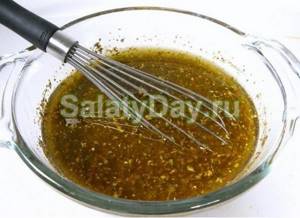
Ingredients:
- Olive oil - ¼ tbsp.
- Lemon juice - ¼ tbsp.
- Garlic - 3 cloves
- Honey - 1 tbsp.
- Mayonnaise - 2 tbsp.
- Red wine vinegar - 1 tsp.
- Salt
- Pepper
Preparation:
Finely chop the garlic or pass through a press.
Mix garlic with mayonnaise, honey and spices.
Stirring constantly, add lemon juice to the mixture first, followed by olive oil. Mix thoroughly until the mass is homogeneous.
At the very end add a little wine vinegar.
What to replace cheeses with?
This pair of cheeses is most often used to make pizza. It is what to replace cheese on pizza that worries chefs most often. There is nothing complicated here. Suluguni, feta cheese, Adyghe cheese are the best helpers here, but there are secrets to substitution.
For example, when using feta cheese, it must first be soaked in milk. The taste will be more tender and there will be less saltiness. The closest thing to Mozzarella cheese is Adyghe cheese.
As a last resort, you can make Morzarella yourself by replacing the milk of young black buffaloes with regular cow's milk. But it is important to know that the components used for cheese making also need to be replaced. For example, you can buy something to replace pepsin for cheese at a pharmacy. After all, pepsin is an enzyme in gastric juice that breaks down proteins. An approximately identical process for making cheese is available with lemon juice and vinegar essence.
The option of replacing “Maasdam” is more complex. This type of cheese can only be replaced by any other hard cheese of limited melting.
By adding cheeses to salads, you can create a culinary masterpiece without much effort. Gruyère cheese is best suited for salads, but how can you replace cheese in a salad if it is not available? It's pretty easy. This type of cheese is one of the hardest types. hence. You can replace it with an affordable durum variety, for example, “Swiss”.
It is very easy to replace the cheese ingredient in the Cheesecake recipe. How to replace cheese in cheesecake if it is Mascarpone, beloved by many? It will be completely replaced by the following composition:
- cream cheese puree,
- high fat cream,
- soft butter.
But if this cheese is needed for the Tiramisu dessert, then the cream should be replaced with rich sour cream. By the way, Ricotta cheese is identical in properties. They can replace Mascarpone when making, for example, sauces. But if the replacement is made for appetizers, then “Ricotta” will create a completely different taste if you mix it with anchovies in mustard.
Cheese is used not only in these popular dishes, as the main ingredient, but also as part of the external decoration of the dish. For example, what can you replace cheese in a casserole if there is none in the refrigerator or it is spoiled? When preparing a casserole, the absence of cheese can be replaced by beaten eggs, which can be used to brush the top of the casserole.
By the way, most people do not eat cheese, considering it a high-calorie product. This is an indisputable fact. But it’s impossible without him. Cheese contains important beneficial substances for the body. Even for deeply religious people, the question arises of what to replace cheese with during Lent. There are several options here. In terms of the composition of microelements and beneficial substances for the body, cheese is on a par with buckwheat, legumes and nuts, but sometimes there is an irresistible desire to taste cheese. Here it is worth purchasing non-dairy cheeses, which are being developed by cheese factories specifically for replacement on fasting days.
And finally, I would like to note that you can replace almost any cheese:
- "Chedar" - Edam cheese;
- "Gorgonzola" - "Viola" cheese;
- "Rikota" - cheeses like "Almette";
- Emmental - Maasdan cheese.
These are varieties of cheeses that interchange each other in all respects. Almost the only difference is the country of origin and some difference in production technology.
Sometimes, reading recipes and comparing them with available products, we throw up our hands in disappointment. To reduce such cases, use our list of interchangeable products for preparing various dishes and everything will work out for you!
Brown sugar
- regular granulated sugar.
Baking powder (baking powder)
can be successfully replaced with baking soda quenched with lemon juice.
Soy flour
- wheat flour.
Butter
1 kg - ghee 850 g - salted butter 1 kg.
Whole milk
1 l - powdered milk 0.1 l.
Melange
45 g - egg (weight with shell) 50 g
Agar-agar
100 g - gelatin 250 g
Lemon
1 piece - citric acid 6-10 g Vanilla
essence
0.5 g - vanillin 0.037 g
Molasses
1 kg - sugar 750 g
Rum
100 g - rum essence 10-15 g - cognac 100 g
Lime
- lemon.
Corn starch
is potato starch.
Dijon mustard
is almost like regular mustard with added sugar.
Tofu
(bean curd or bean cheese made from soy protein) can be replaced with milk curd.
It has no taste as such, which makes it great with any product. It can be fried, pickled, stewed, used as a puree, etc. Although its taste is not too similar to the usual milk curd, it can also be used. Maple syrup
can easily be replaced with honey.
Balsamic vinegar
- wine vinegar.
And if you want to get a little closer to the original taste of balsamic vinegar, try infusing wine vinegar with herbs and spices. This will give it a more refined taste and aroma. Proportions – 1 cup of herbs to 2 cups of vinegar. For example, apple. Wormwood and tarragon are delicious to use in making vinegar. To begin, leave the herbs in a dark, warm place overnight to dry. Pour the vinegar over the herbs until the vinegar covers them completely. Leave to brew for 6 weeks in the dark; the tincture should also be stored in the dark, remembering to shake it from time to time. Coconut milk
- in sauces, coconut milk can be replaced with low-fat (10-15%) cream, in desserts - with regular milk.
Fromage frais
- with thick yogurt or sour cream.
Artichoke
– Canned artichokes can be substituted for fresh artichokes.
And canned artichokes are replaced with canned sweet peppers. Leeks
can also be replaced with onions and vice versa - for a milder taste you can replace onions with leeks.
Asparagus
- broccoli or any vegetable with a delicate taste and texture - cauliflower, sugar snap peas.
Quark
– cream cheese.
Papaya
is a melon.
Parsnip
- celery root.
Spinach
- ordinary sorrel.
Garam masala
is a mixture of at least five spices: cardamom, cloves, cumin (jeera), cinnamon, coriander.
It's better ground, but you can also use it whole. Chocolate
- 3 tbsp.
l. cocoa powder and 1 tbsp. l. vegetable oil Buttermilk
- replaced with half milk and half natural yogurt.
The second substitute is kefir. Polenta
is corn grits.
By grinding it in a coffee grinder you will get real flour for making polenta. Radicio
- regular salad or red cabbage, depending on the recipe.
Sour cream
- natural yogurt and vice versa.
Whipped cream
- 1.5 cups of condensed milk and tsp.
lemon juice. Whip as you would regular cream. Another option for replacing whipped cream is to mash a banana and beat it with an egg white. Add a couple drops of vanilla extract and sugar. Oregano
- marjoram.
Curdled milk
1 glass - 1 table.
a spoonful of lemon juice mixed with a glass Corn starch
- can be replaced with any other starch.
Capers
(unopened buds of the thorny caper bush) - you can replace them with olives, black olives or gherkins.
Fennel
- cumin.
Sesame oil
- olive oil.
Feta cheese
– feta cheese, or vice versa.
Mozzarella cheese
is replaced with suluguni cheese.
Natural yogurt
- low-fat sour cream.
Mascarpone cheese
- full-fat cottage cheese or a mixture of heavy cream and cottage cheese.
Ricotta cheese
- homemade cottage cheese.
Shallots
- onions.
Olive oil
- any vegetable oil.
Baking powder
(baking powder) is a mixture of a quarter teaspoon of citric acid, half a teaspoon of soda and one teaspoon of flour.
Corn starch
is replaced with potato starch.
White wine
can be replaced in any sauce by 2 pieces of sugar dissolved in a small amount of vinegar.
Pancake flour
can be made by combining wheat flour and baking powder.
Pine seeds
- replace with walnuts or almonds.
Parmesan cheese - any hard cheese. Japanese sushi rice
- any short grain rice.
Wasabi
- sometimes replaced with mustard or a mixture of mustard and horseradish, but the taste is not equivalent.
Rice vinegar
is replaced with specially prepared grape vinegar.
You can simply dilute it a little with water (since rice vinegar is less spicy), or improve it according to the following recipe. Mix 4 tbsp. spoons of vinegar, 1 tsp. salt and 3 tsp. sugar and heat over low heat, without boiling, until the salt dissolves. Japanese soy sauce
- another natural soy sauce, slightly diluted with water.
Mushrooms with Japanese names
are local mushrooms.
Daikon
is replaced with radish or green radish.
Mitsuba greens
are replaced with parsley.
Shiso leaves
are replaced with lettuce leaves.
Shellfish juice
can be replaced with fish broth.
Feta cheese is a white pickled cheese made from sheep's milk with the addition of goat's milk, a traditional Greek product with a characteristic expressive salty taste with a pleasant delicate lactic acidity, fat content from 30 to 60%. In appearance, this cheese is in some ways similar to fresh, fine-grained pressed cottage cheese. The ripening period for cheese in brine is at least 3 months. Technologies for the production of such cheeses were known back in ancient times; most likely, they were practiced earlier.
The name “Feta” is protected by EU laws; cheese with this name is produced only in Greece and is sold with an indication of the place of origin. Similar cheeses are produced using similar technologies, sometimes with changes in the recipe, in other countries (Mediterranean, southeastern Europe, etc.). To produce such cheeses, not only sheep and goat milk is sometimes used, but also cow and buffalo milk. These products have different trade names.
- an ingredient in many dishes, often appearing in various recipes, but we cannot always and not everywhere find this cheese on sale, and this product is not cheap.
What can you substitute for feta cheese?
The answers arise naturally from simple logical reflections. Feta cheese should be replaced with brined cheeses. And which ones exactly?
In retail chains you can find pickled cheeses with the names “Fetaki”, “Fetaxa”. Some people successfully replace feta cheese, for example, with Adyghe, Suluguni, mozzarella and other similar pickled cheeses.
And yet, what is the best way to replace feta cheese to make it tasty and profitable?
The answer may surprise some, but it is unlikely to surprise those living in Greece, Macedonia, Bulgaria, Romania, Moldova, other Balkan countries or Israel.
It is best to replace feta cheese with regular feta cheese - this brined cheese is most similar to feta in technology and composition. Brynza is produced both industrially and traditionally at home.
Cheese cheese is similar to feta not only in terms of production methods and composition, but also as close as possible in taste and structure. Brynza (as well as other pickled cheeses) in its own way is no less healthy than feta. There’s just one “but”... Brynza, especially aged cheese, is a fairly salty cheese, usually saltier than feta cheese.
Greek salad dressing with honey
The combination of honey and mustard gives a pleasant sweet and sour taste to the dishes in which they are added. This dressing will go very well with Greek salad.

Ingredients:
- Honey - 1 tbsp.
- Vegetable oil - 5 tbsp.
- Mustard - 2 tsp.
- Garlic - 3 cloves
- Lemon juice - 50 ml.
Preparation:
Pass the garlic through a press. Mix with mustard, honey and vegetable oil until smooth.
Add lemon juice and stir again.
Original salad dressing
According to the classic “village” recipe, Greek salad is dressed only with olive oil. With just a small addition. To create the necessary fragrant bouquet and unique taste, lemon juice and Provencal herbs are added to high-quality cold-pressed olive oil.
Salad dressing should always be prepared in advance so that all its components are combined with each other, and it has time to brew and become saturated with their aromas. For it you will need: 70 ml of olive oil, the juice of half a lemon (can be replaced with a tablespoon of wine or balsamic vinegar), aromatic herbs (oregano, thyme or Provençal).
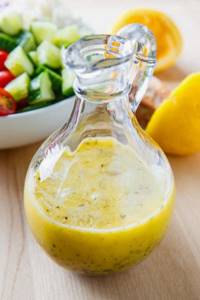
Therefore, the true taste of the dish depends not only on what kind of cheese will be present in the Greek salad, but also on the dressing itself. Now all that remains is to collect all the ingredients together and proceed directly to the cooking process.
Greek salad dressing with basil
A very simple but successful salad dressing. Despite the large amount of ingredients, it only takes a couple of minutes to prepare. All you need is a blender!
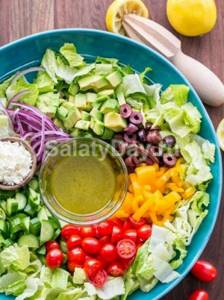
Ingredients:
- Olive oil - 3 tbsp.
- Lemon juice - 1 tbsp.
- Sweet mustard - 1 tsp.
- Garlic - 1 clove
- Oregano
- Basil
- Salt
- Pepper
Preparation:
Place all ingredients in a blender and mix.
Let it brew before serving.
Egg yolk based Greek salad dressing
A zesty and simple dressing that will give Greek salad a pleasant, mild flavor. This is one of the most common recipes, after the classic version.

Ingredients:
- Boiled yolk - 2 pcs.
- Olive oil - 100 ml.
- French grain mustard - 100 g
Preparation:
Grind the yolks with a fork and mix with olive oil until smooth.
Add mustard and mix everything again until smooth.
It is most convenient to mix the ingredients in a blender. But, if you want the mustard seeds to remain intact in the sauce, it is better to do it by hand, adding the mustard at the end.
Easy Greek Salad Dressing
A simple sauce with added oregano. It turns out very tasty, and the cooking process does not take much time and effort.

Ingredients:
- Olive oil - ½ tbsp.
- Lemon juice - ½ tbsp.
- Garlic - 1 clove
- Oregano
- Salt
- Pepper
Preparation:
Pass the garlic through a press and add to the olive oil.
While stirring, pour in lemon juice. The mixture should be homogeneous.
Salt, pepper, add oregano and mix again.
Greek salad dressing with mayonnaise and nutmeg
Be sure to try this version of the Greek salad dressing! The unusual combination of mayonnaise and nutmeg is an excellent addition to vegetables and gives the dish new flavor notes.

Ingredients:
- Olive oil - ¼ tbsp.
- Lemon juice - ¼ tbsp.
- Garlic - 1 clove
- Honey - 1 tbsp.
- Wine vinegar - 2 tsp.
- Mayonnaise -2 tbsp.
- Ground nutmeg
- Ground cardamom
- Salt
- Pepper
Preparation:
Pass the garlic through a press and mix with mayonnaise.
Add honey and spices to the mixture. To stir thoroughly.
Without ceasing to stir, pour in olive oil in a thin stream, followed by lemon juice.
At the very end add wine vinegar.
Greek salad with oregano, dill and mint
We looked at two ways to prepare Greek salad. A classic recipe is good, but sometimes you want something unusual. The following refreshing salad is especially for such an occasion.
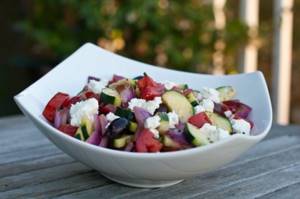
Ingredients:
- Tomato - 2 medium (300-350 gr.);
- Cucumber - 2 small (150-200g);
- Sweet pepper - 1 pc.;
- onion - head;
- Olives;
- Feta - 200-300 gr.;
- Vegetable oil - 50 ml;
- Wine vinegar - 10 ml;
- Mint leaves;
- Oregano;
- Dill;
- Lettuce leaves;
- salt.
Preparation:
- Prepare the dressing - mix oil, vinegar and oregano.
- Cut vegetables. Cut the tomato and cucumber into medium cubes, and the pepper into thin strips. Speaking of pepper, in this salad it also plays an aesthetic function; it is better to take yellow, this will add color contrasts to the salad (cucumbers are green, tomatoes are red, yellow peppers). You can swap the peppers with tomatoes, take a yellow variety of tomato, then the pepper will be red. Cut the onion into thin half rings.
- Mix vegetables in a deep dish.
- Chop the greens (mint and dill). Add to vegetables.
- Add salt and stir the vegetable mixture.
- Add olives to vegetables.
- Dress the salad, leaving a little dressing.
- Roll 1/2 of the cheese, cut into medium cubes, in the remaining dressing - this will give the cheese visual appeal. Also, this trick is of practical importance; after soaking in oil, the cheese does not stick together.
- Place lettuce leaves on a plate. On top of them are some vegetables. This is followed by a layer of cheese that has been in oil, and the rest of the vegetables are laid out on top of it.
- Place the remaining cheese on the plate where the vegetables were mixed, add oil and oregano, stir.
- Place the cheese on top of the salad and crush the oregano.
- Garnish the salad with a sprig of mint.
A very beautiful, spicy and refreshing salad is ready to become the highlight of your holiday table.
Pesto sauce for Greek salad
Based on herbs, you will make an excellent dressing for your favorite salad. Very simple, and very fast!

Ingredients:
- Oregano
- Basil
- Olive oil – 150 ml
- Garlic -2 cloves
- Sesame nuts - a handful
- Salt
- Pepper
Preparation:
Grind the leaves of herbs using a blender.
Add sesame nuts, spices, garlic, olive oil and mix again with a blender.
Greek salad dressing with spices
It is the spices that infuse the oil with aromas and flavors, turning it into a sauce. This sauce is prepared quickly, but it needs time to brew and soak in the flavors.

Ingredients:
- Soy sauce - 3 tbsp.
- Olive oil - 6 tbsp.
- Lemon juice - 3 tbsp.
- Honey - 1 tbsp.
- Khmeli-Suneli
Preparation:
Mix soy sauce and honey thoroughly until smooth. Add lemon juice and mix again.
While whisking, pour in olive oil in a thin stream.
Add spices.
How to replace Feta cheese at home
What pickled cheeses can replace Feta cheese in taste? Brynza and Suluguni are suitable; they are prepared in the same way, but they differ in that they are saltier, less caloric and are pressed during cooking. Salt can be removed from such a product by soaking it in milk for 12 hours.
It's fine to use cow's milk, but goat's or sheep's milk would be better, since they do not contain lactose and are not allergens. Due to the high percentage of fat content, they are not suitable for those on a diet.
"Universal" dressing for Greek salad
You can try to add new notes to the usual taste of the salad with any other dressing suitable for vegetable salad. We offer a recipe for one of the universal dressings.

Ingredients:
- Olive oil -3 tbsp.
- Vinegar 6% - 1 tbsp.
- Honey - 1 tsp.
- Whole grain mustard - 1 tsp.
- Garlic - 1 clove
- Salt
- Pepper
Preparation:
Finely chop the garlic.
Mix honey and mustard until smooth. Without ceasing to stir, pour in the olive oil.
Add vinegar and spices.
Just cheese...
In addition to “exotic” varieties, many salads use regular hard or semi-hard cheese. And what to do if only at the very last moment it was not in the refrigerator? Hard cheese in salad can be replaced with processed cheese. To make the processed cheese easier to cut or grate, you can first keep it in the freezer for 15-20 minutes.

Smoked sausage cheese is also a great substitute. It has a specific taste and can even give a familiar salad a new twist. For salads made from fresh vegetables, you can safely use salted cottage cheese or feta cheese. In general, when choosing a cheese replacement, you can rely on your taste and culinary sense.
Greek Yogurt Salad Dressing
This dressing is suitable for Greek salad, which contains feta cheese instead of feta, softening its salty taste. In addition, those who are watching their figure can use this recipe by removing the olive oil from it and replacing full-fat yogurt with a more dietary one.
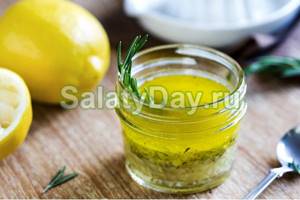
Ingredients:
- Full-fat Greek yogurt - 100 ml
- Garlic - 1 clove
- Lemon juice - 1 tbsp.
- Olive oil - 2 tbsp.
- Oregano
- Rosemary
- Mint
- Parsley
- Salt
- Pepper
Preparation:
Using a mixer, beat yogurt with finely chopped garlic, lemon juice and olive oil.
Finely chop the herbs, mash with a spatula and add to the whipped mixture.
Salt and pepper.
Chees Feta
This type of cheese is traditionally used to make Greek salad. Feta is a pickled cheese. It has a slightly salty taste and crumbles easily in your hands. Obviously, instead of Feta you can take feta cheese or Adygei cheese. They are the same type of cheese, but have a saltier taste. To get rid of it, you can soak the cheese in milk in advance or add less of it than according to the recipe.
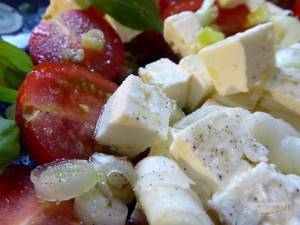
You can also replace Feta with grainy cottage cheese. It is enough to throw it on a sieve to remove the cream. It will be similar to it not only in structure, but in taste. All that remains is to salt and season the salad well. Even gourmets have difficulty distinguishing cottage cheese from the original Feta cheese.




